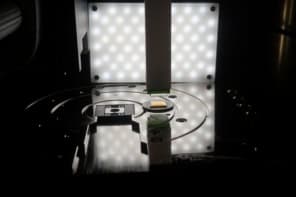
Physicists in Canada and Germany have invented new a way of changing the direction of electron spins by bouncing them along a tiny semiconductor channel. Unlike other schemes for spin flipping in a semiconductor, it does not involving applying an oscillating electric or magnetic field. As a result it could be easier to implement in “spintronic” devices of the future.
Electron spin can take on two values — “spin up” or “spin down” — and some physicists believe that this property could be used in spintronic circuits that process information faster and more efficiently than today’s computer chips. But before this can happen, researchers have to work out a simple and reliable way to flip spins that can be implemented in tiny mass-produced chips.
The new method was created by Joshua Folk and colleagues at the University of British Columbia and University of Regensburg. It works by injecting electrons into a gallium arsenide channel, which is about 1 μm wide and 100 μm long. The electrons move easily through the channel but reflect off the walls — so electrons injected at an angle to the direction of the channel bounce back and forth as they travel through (see figure).
Alternating torques
The team used a tiny piece of semiconductor called a quantum point contact (QPC) to inject electron spins that all point in the same direction. When an electron bounces off one wall, its spin feels a torque because of an effect called spin-orbit (SO) coupling — and when it bounces off the opposite wall it feels a torque in a different direction. This alternating torque has a frequency defined by the speed of the injected electrons, their angle of injection and the width of the channel.
A fixed magnetic field is applied across the width of the channel, which causes the electron spins to wobble like spinning tops around the direction of the field. The team found that when the frequencies of the alternating-torque and the wobble were exactly the same, the spins flipped.
The team has dubbed this effect “ballistic spin resonance” because the electrons move through the channel like bullets — and because the effect is similar to electron spin resonance, where the alternating torque is provided by an oscillating magnetic field.
There are, however, several shortcomings that must be overcome before ballistic spin resonance can be used in practical devices.
Impurities are a problem
One problem is that electrons can scatter from impurities in the channel resulting in additional random torques. As a result spin-flipping process is not coherent and the electron spins are not left in a specific orientation.
Another shortcoming is that the electrons are injected at a range of angles, which means that not all spins will experience the same alternating-torque frequency.
These problems could be alleviated by using semiconductors with fewer impurities, and by collimating the injected electrons, say the researchers.
The results are published in the journal Nature.



